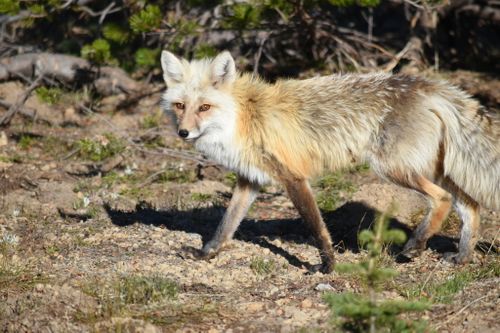
THE CASCADE RED FOX
A small-sized canid, with long and slender legs and pointed muzzle, and long
brush-like tail. This is a montane, small-sized subspecies of North American Red Fox, with a
relatively short tail, deep rusty to yellow in color. Pelage is straw yellow to deep rusty dorsally
grading to rusty grizzled with white posteriorly and lighter rust along sides. Underfur is light
gray. It is the subspecies most likely to produce "cross" color morphs.
Throat and chest are white with gray underfur. Belly is all white. Muzzle slender and
pointed, white on upper lip. Ears relatively large, pointed, erect, black backed, white inside.
Black of ears and feet greatly restricted. Tail very pale, sparsely overlain with black-tipped
hairs, tipped with white. Silver phase is common, being entirely black except for an area on
the posterior dorsum grizzled with white and sometimes an area grizzled with white on the
shoulders, and the white tip on the tail. Females are slightly smaller than males.
Reproduction and behavior
- Gestation: 51-53 days.
- Young per birth: 4-8.
- Weaning: 60 days.
- Sexual maturity: unknown, expected around 9 months.
- Life span: unknown, expected around 3 and 7 years.
- Breeding season: Late January to early February.
Births occur from
mid-March to mid-May. Dens are located in stands of trees, and
their placement, the number of entrances, and their size are not
different from those of other subspecies in North America. Social behavior: Mated pairs.
Diet and interaction with the environment
Their diet consists in pocket gophers, voles,
lagomorphs, insects, and fruit and berries, but also birds and their eggs,
opossums, insectivores, a variety of other rodents, and occasionally
other carnivores; in local situations it consumes garbage and carrion.
In the winter, mammals are the principal food items; in the spring, birds
become a minor component of the diet and continue as such through
the summer and fall; in the early summer, fruits and insects are important
food items.
Their main predators are the coyote. This montane subspecies appears
to be specialized for occupying subalpine and alpine habitats, and may
possess physiological adaptations that other populations lack. Home
ranges are small in subalpine meadows, larger in poorer habitat on the
eastern slope of the Cascades. They do not migrate to lower elevations in
winter, although they increase their home range size during the months
when snow is on the ground.
Habitat:
The Cascade Red fox is native to Canada and United States. This subspecies
occurs on the northwestern coast of the United States and Canada, Southern British Columbia, Cascade Range in Oregon and Washington, and
Northern Sierra Nevada in California, but the limits of its range are not
well defined. It occurs at low abundance throughout Mount Rainier
National Park, at sites on the Gifford Pinchot National Forest, and
as sparse detections in the North Cascades ecosystem. Some
authors state that Oregon animals are the necator subspecies.
Their habitat is restricted to upper montane forest, subalpine parkland,
and alpine zone of Cascade Range. This subspecies appears able
to move through areas of timber, but dense timber may partially
obstruct movement and colonization. Lowland populations
probably correspond to other introduced subspecies.

Conservation status: Least Concern. Regional status: Critically imperiled in Oregon and Washington. It is
one of the most threatened subspecies, as its range is small and
apparently much reduced from historical times, facing numerous
threats. The population size at Mount Rainier and Mount Adams
is unknown, and its status elsewhere in its range is unknown.
Significant threats to all populations include growing coyote
populations, which increase risk of predation and competition,
habitat loss and fragmentation due to recreational development,
and habitat loss due to encroachment of woody vegetation. There
is a potential for genetic erosion, due to small population sizes.
Physiognomic information:
- Body length: 60-71 cm (♂), 56-58 cm (♀)
- Tail length: 32-41 cm
- Height: 38-44 cm
- Weight: 4-4.5 kg (♂), 3.5-3.7 kg (♀)
- Skull: ~15 cm
Taxonomy:
The North American red foxes have been traditionally considered either as subspecies of the Old World red foxes, Vulpes vulpes, or subspecies of their own species, Vulpes fulva. Due to the opinion that North American red foxes were introduced from Europe, all North American red foxes have been seen as conspecific with Vulpes vulpes; however, genetic analyses of global red fox haplotypes indicates that the North American red foxes have been genetically isolated from the Old World populations for 400,000 years, prompting possible application of Vulpes fulva to all North American red foxes.
Castello (2018) has formalized treatment of Vulpes fulva as a separate species from the Old World Vulpes vulpes. In 2014, Mark J. Statham among others released a study that supports Vulpes fulva as a separate species from the Old World Vulpes vulpes. More about the Vulpes vulpes fulva and Vulpes fulva discussion:
Gallery:
Due to the similarity in appearance between North American Red Foxes, some of the images may be erroneous. That's why I haven't found any videos about this subspecies either, if you think you have any image or video of the Vulpes fulva cascadensis let me know in the comments or contact me on any of my social networks (@etzharai).


















No hay comentarios:
Publicar un comentario